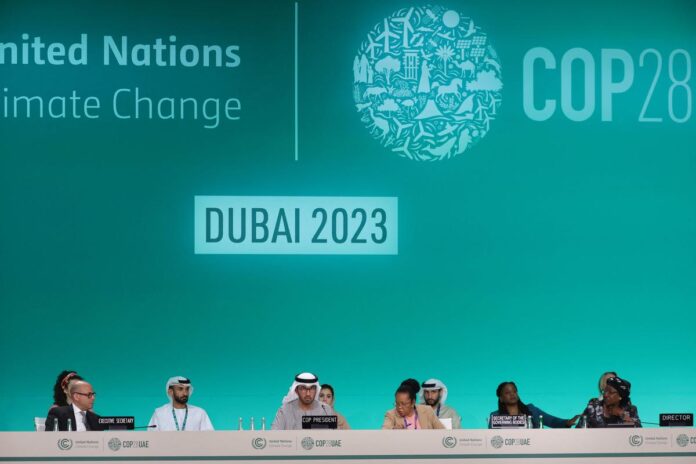The United Nation Framework Convention on Climate Change (UNFCC) is the global community’s annual ritual for finding

By: Dr VK Bahuguna
The United Nation Framework Convention on Climate Change (UNFCC) is the global community’s annual ritual for finding collective solutions for the global warning starring at the face of humanity. It is conducted as the name suggests under the banner of United Nation. The United Nation is always in the vortex of controversies as from one crisis to another it has generally failed to achieve the targets of world peace and prosperity. Already the world peace is in danger due to the prolong wars between Ukraine and Russia and between Israel and Hamas. This Conference of Parties (CoP) is 28th in the sequence of climate change negotiations and was held in Dubai in the United Arab Emirates (UAE). The proceedings were chaired by Dr Sultan al-Jaber the Industry and Advanced Technology Minister of UAE. He is an Engineer, Politician, Businessman and heads the Abu Dhabi National Oil Company. The final draft declaration apparently takes into account the arguments of Global Stock take and calls for “increasing climate action and access to finance for communities and countries threatened or affected by fragility or conflict or facing severe humanitarian needs; to strengthen knowledge and programmatic solutions for climate action in such settings; and to foster collaboration at multiple levels and across regions and humanitarian, development, climate, and peace actors to address the multi-dimensional challenges of climate change”. The climate deal signed by around 200 countries was hailed by Al Jaber as historic package particularly for the oil rich countries agreeing for agreement on using the phrase ‘transiting away’ from fossil fuel (rather than using the more emphatic word ‘phase down’). Al Jaber while chairing the session termed the deal as a ‘robust plan’ to limit the global temperature rise to 1.5 degree Celsius. While addressing the Plenary Dr Al Jaber stated “we must take necessary steps to turn this agreement into tangible action”. But the question remains to be seen how swift, just and equitable will be this transition from fossil fuel?. For this to be ensured, it is necessary to either go for very heavy cuts in emission or to use technologies to offset the losses and, the need for trillions of dollars finance otherwise, the declaration may remain as an attempt by the diplomats to proclaim the negotiations as success with appropriate words.
This writer has been closely following the outcome of different CoPs. There are always differences between the developed world and the developing world on how to move forward on combating climatic vagaries and this CoP notwithstanding the agreement of ‘transitioning away’ from fossil fuels is no exception. Without a very firm ‘action program’ with clear identification of finance it will be difficult for the world to achieve a net zero carbon emission by 2050 as agreed in Cop28. Any global tangible action program depend upon developed countries first realizing about their contribution in global warning and their willingness to fund the developing world to access superior technologies. On the other hand the developing countries also must realize including India that they need to take up climatic resilient development on their own and focus on research to develop technologies to meet the targets of emission reduction. India for example, is moving in right direction as per the Paris agreement of 2015. India is to achieve its short term and long term targets under the Panchamrit action plan, i.e. reaching a non-fossil fuel energy capacity of 500 GW by 2030; fulfilling at least half of its energy requirements via renewable energy by 2030; reducing CO2 emissions by 1 billion tons by 2030. By the end of year 2030 India will be reducing the carbon intensity by 45 % and with a target of net Zero emission by the year 2070. Indian emissions in 2022 were only 8% of the global emission, where as China leads with 32% of the global total (11.4 billion metric tons of Carbon) followed by USA with 14 (5.1 billion metric tons of Carbon) %. The European Union also accounts for the 8% of the global total. Going by the per capita emission USA leads the tally with 15.32 tons, Russia in 11.45 tons, China 7.44 tons and India less than 2 tons. It is thus clear that inter-generation equity need to be considered by the world leaders to devise workable and firm and implementable solutions for meeting the targets to limit temperature to 1.5 degrees.
The situation however, is grim except for agreement on fossil fuels which this writer terms as a face saving formula to prevent the collapse of dialogue there is nothing substantial on how to targets and its monitoring specially for augmenting climate funding for the poor and developing countries. The fact is in many locations in the world the temperature has already crossed to 1.5 degree. In India alone the average rise is in the range of .7 degree to 1 degree in many locations according to a data collected by Indian Council of Forestry Research and Education for the period from 1930 to 2010 in around 90 meteorological stations located in forest areas. The data revealed massive changes in the forest vegetation and thus in hydrology. Going by the past experience the Cop 28 declaration may prove a verbose and vacuous declaration yet again if the UNFCCD secretariat does not come up with a sound and time bound program without waiting for the CoP 29. For this the world leaders must meet soon to take stock and respect the forecasts of Inter-Governmental Panel on Climate Change (IPCC) and come up with a collective action program as the Earth and the people living on it are waiting for the humanity to act without fail.
India as the leading light of global south need to think and act innovatively and lead by chalking out a format for south-south cooperation on meeting the needs of finance and helping each other in sharing and developing the technologies. If concerted efforts are made by India and China and the oil rich countries a substantial program can be evolved. India should also shift focus in its district and block level planning to make it climatic resilience with focus on resource management particularly water conservation, hydrology and forest management with integration of primary sector activities for better climate change adaptation and mitigation.
(The writer is former Director-General in the Environment Ministry govt of India)



superb, amazingly excellent